The health of our arteries plays a vital role in determining not only our lifespan but also our ability to perform, move, and live with energy and clarity. Arteries are responsible for delivering oxygen and nutrients throughout the body, fueling every heartbeat and every stride. When they become clogged—a process known as atherosclerosis—the risk of coronary artery disease (CAD), heart attacks, and strokes increases dramatically. Fortunately, research continues to show that natural, lifestyle-based approaches can significantly improve cardiovascular health. This article explores how to prevent clogged arteries and CAD using expert-backed strategies rooted in endurance training, proper nutrition, and holistic health practices. With a focus on building healthy arteries and lasting performance, these insights are designed to empower readers with practical tools for long-term well-being.
You may also like: Smart Nutrition Choices for a Healthier Lifestyle: What to Know About Whole Grain Rice and Whole Wheat Rice
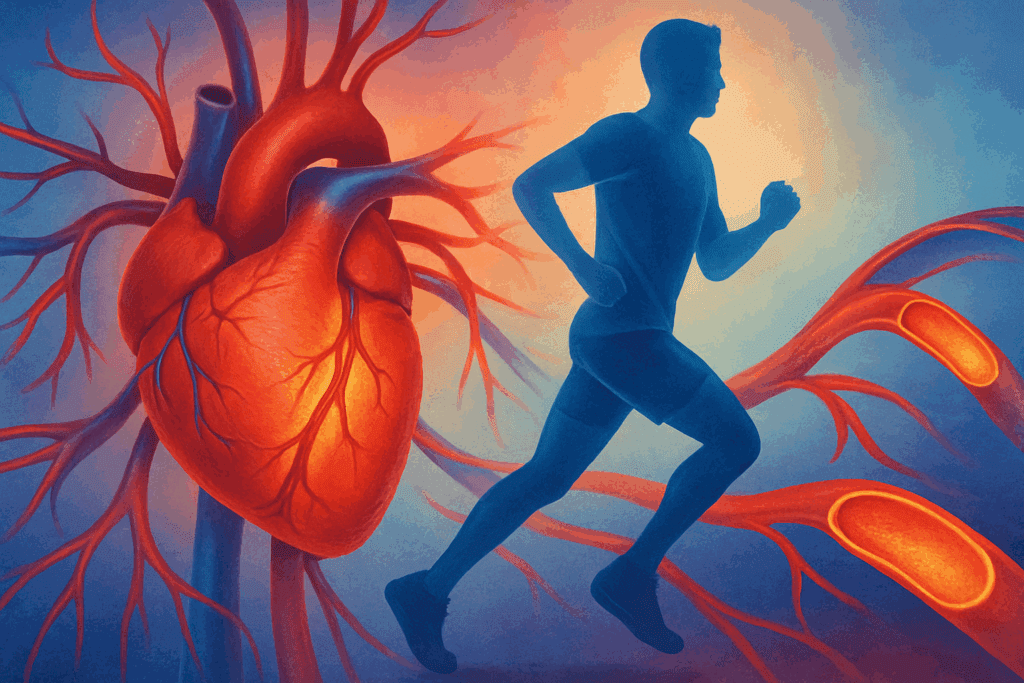
Understanding the Connection Between Endurance, Heart Health, and Arterial Integrity
Endurance isn’t just a trait of elite athletes; it’s a fundamental aspect of cardiovascular fitness that reflects the heart’s ability to pump efficiently and the blood vessels’ capacity to deliver oxygen-rich blood. When arteries are healthy, they remain flexible and free from obstructions, allowing blood to flow smoothly. Clogged arteries, by contrast, can increase resistance in the system, elevate blood pressure, and reduce oxygen supply to muscles and organs—ultimately compromising endurance and daily function.
Regular aerobic exercise improves the function of the endothelium—the inner lining of arteries—by increasing nitric oxide production, which facilitates vessel dilation and blood flow. This has been shown to counteract the early stages of atherosclerosis and improve overall cardiovascular efficiency. Athletes and active individuals often exhibit lower inflammation, better lipid profiles, and enhanced arterial elasticity, demonstrating the clear link between endurance activity and cardiovascular resilience.
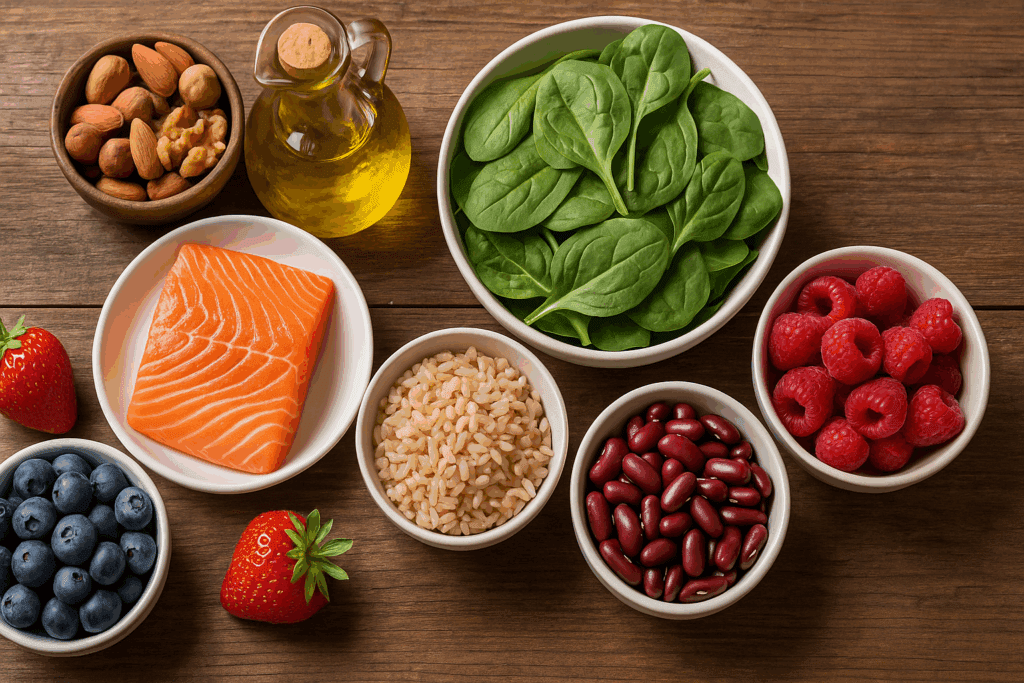
How to Prevent Clogged Arteries in the Heart Through Strategic Nutrition
Nutrition forms the cornerstone of cardiovascular health. How we eat significantly influences whether arteries remain open or begin to narrow due to plaque buildup. A dietary pattern rich in whole, minimally processed foods—especially the Mediterranean diet—is consistently associated with lower risks of CAD. This approach emphasizes healthy fats, lean proteins, fiber-rich vegetables, and antioxidant-laden fruits.
Foods like fatty fish, extra virgin olive oil, flaxseeds, and walnuts are abundant in omega-3 fatty acids, which reduce inflammation and lower triglyceride levels. Leafy greens, berries, legumes, and whole grains offer fiber, polyphenols, and plant-based nutrients that combat oxidative stress—a major contributor to arterial damage. Soluble fiber, in particular, helps reduce cholesterol absorption in the gut, further supporting the prevention of clogged arteries in the heart.
Conversely, diets high in sugar, trans fats, sodium, and refined carbohydrates can accelerate inflammation and endothelial dysfunction, raising the risk of plaque formation. Learning how to prevent CAD through nutrition requires conscious choices that prioritize natural, nutrient-dense foods that support vascular health on a cellular level.
Using Endurance Training to Support Long-Term Cardiovascular Resilience
Exercise is not optional when it comes to heart health—it’s essential. Regular cardiovascular activity strengthens the heart muscle, improves circulation, and contributes to better metabolic function. Endurance training, such as brisk walking, cycling, swimming, or running, has been shown to reduce blood pressure, lower LDL cholesterol, and increase HDL cholesterol—all factors linked to reduced CAD risk.
The American Heart Association recommends at least 150 minutes of moderate-intensity aerobic activity per week, or 75 minutes of vigorous activity. For those wondering how to prevent CAD naturally, this level of activity can dramatically reduce systemic inflammation and improve overall fitness. Incorporating high-intensity interval training (HIIT) can further enhance vascular function and promote insulin sensitivity, which are both protective factors for heart disease.
In addition to physical improvements, exercise also has mood-enhancing benefits and helps regulate stress hormones like cortisol, which are known to impact blood pressure and heart rate variability. In short, building endurance is a powerful and sustainable strategy for promoting healthy arteries and extending quality of life.
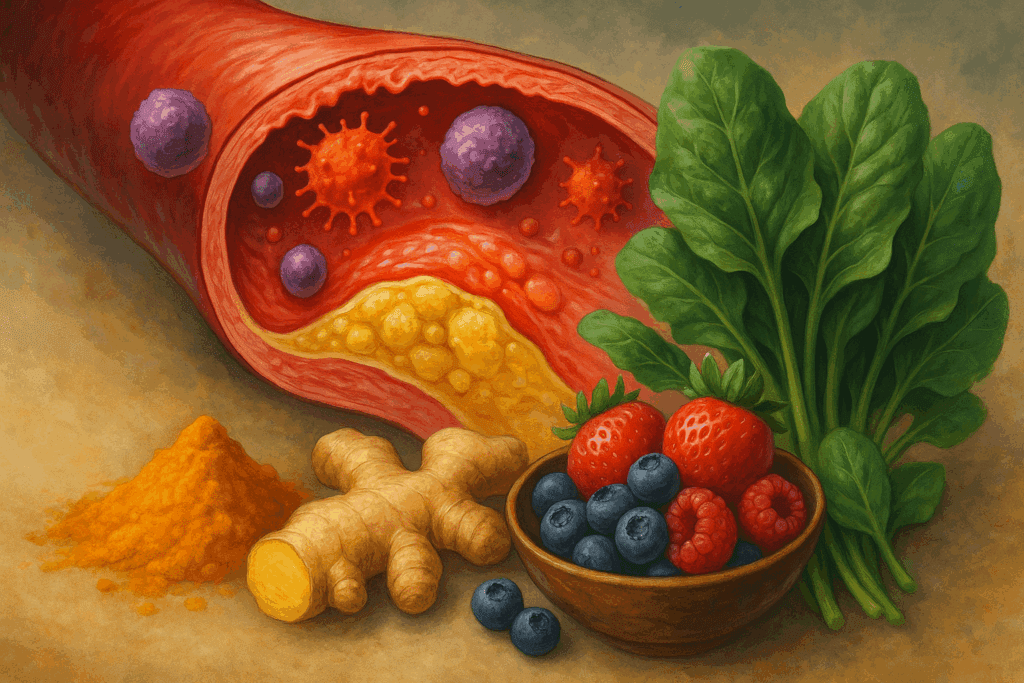
Tackling Inflammation: The Hidden Driver of Arterial Disease
One of the less visible yet profoundly impactful contributors to clogged arteries is chronic inflammation. Inflammation can damage the arterial lining, making it easier for cholesterol to penetrate and form plaques. Over time, these plaques can rupture, triggering blood clots and potentially life-threatening events like heart attacks.
Fortunately, both diet and exercise can reduce inflammation. Anti-inflammatory foods—such as turmeric, ginger, berries, green tea, and leafy greens—help counteract oxidative stress and support immune balance. Regular endurance training also reduces circulating inflammatory markers like C-reactive protein (CRP) and interleukin-6, further supporting vascular function.
Managing stress is another essential element. Chronic stress increases inflammation and can raise blood pressure and cholesterol. Practices like meditation, deep breathing, and yoga have been shown to activate the parasympathetic nervous system, supporting vascular relaxation and arterial repair. Those who prioritize mind-body practices often experience improved resilience and reduced cardiovascular strain.
Understanding Cholesterol’s Role in Arterial Health
Cholesterol, while often portrayed negatively, is not inherently bad. In fact, the body needs cholesterol to build cells and produce hormones. Problems arise when there is an imbalance—particularly when levels of oxidized LDL (low-density lipoprotein) cholesterol become elevated, increasing the risk of plaque accumulation in the arteries.
Learning how to prevent clogged arteries in the heart involves more than just lowering LDL. It also requires increasing HDL (high-density lipoprotein) cholesterol, which helps remove excess cholesterol from the bloodstream. Endurance exercise plays a vital role in this process, as does replacing saturated and trans fats with unsaturated fats from sources like avocado, nuts, and seeds.
In some cases, lipid abnormalities may have genetic components, such as elevated lipoprotein(a), but lifestyle remains the first line of defense. A balanced approach that includes endurance activity, anti-inflammatory foods, and appropriate micronutrient support is key to keeping cholesterol in check and arteries clear.
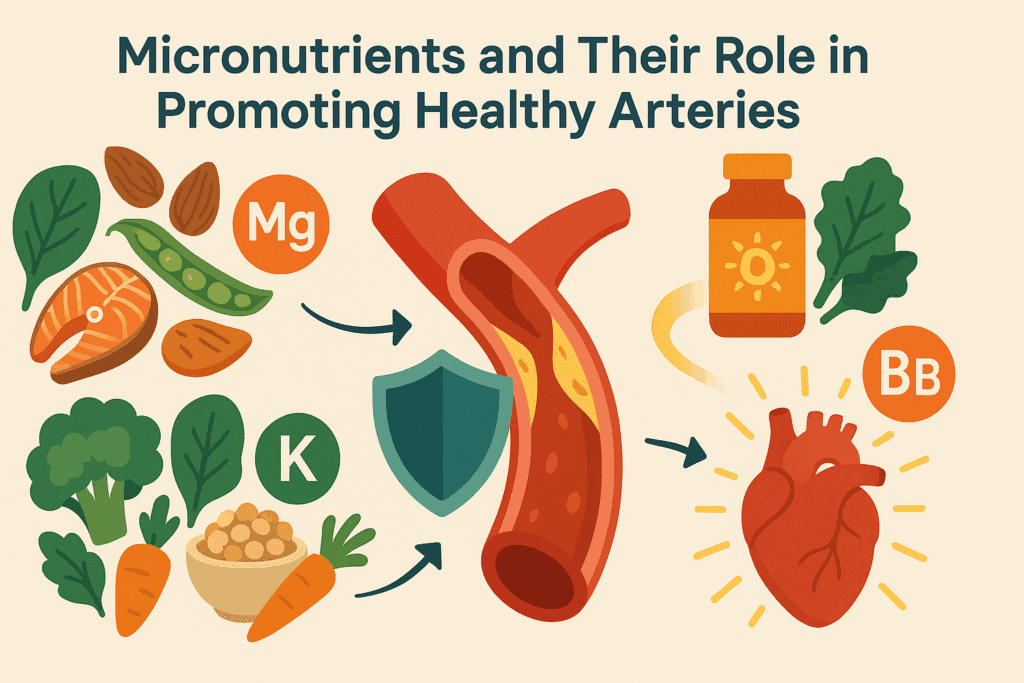
Micronutrients and Their Role in Promoting Healthy Arteries
Beyond macronutrients like fats, carbs, and protein, certain vitamins and minerals are essential for vascular function. Deficiencies in magnesium, potassium, vitamin D, and B-complex vitamins have all been linked to increased cardiovascular risk.
Magnesium helps maintain normal blood pressure and muscle relaxation, while potassium balances sodium and reduces fluid retention. Vitamin D plays a regulatory role in immune function and has been associated with improved arterial elasticity. B vitamins help lower homocysteine—a compound linked to arterial damage when elevated.
To maintain healthy arteries and reduce CAD risk, it’s important to include a wide variety of nutrient-dense foods in the diet. Legumes, leafy greens, nuts, whole grains, and fatty fish provide a strong foundation for cardiovascular support. In some cases, supplementation may be helpful under medical supervision, particularly for those with identified deficiencies or absorption issues.
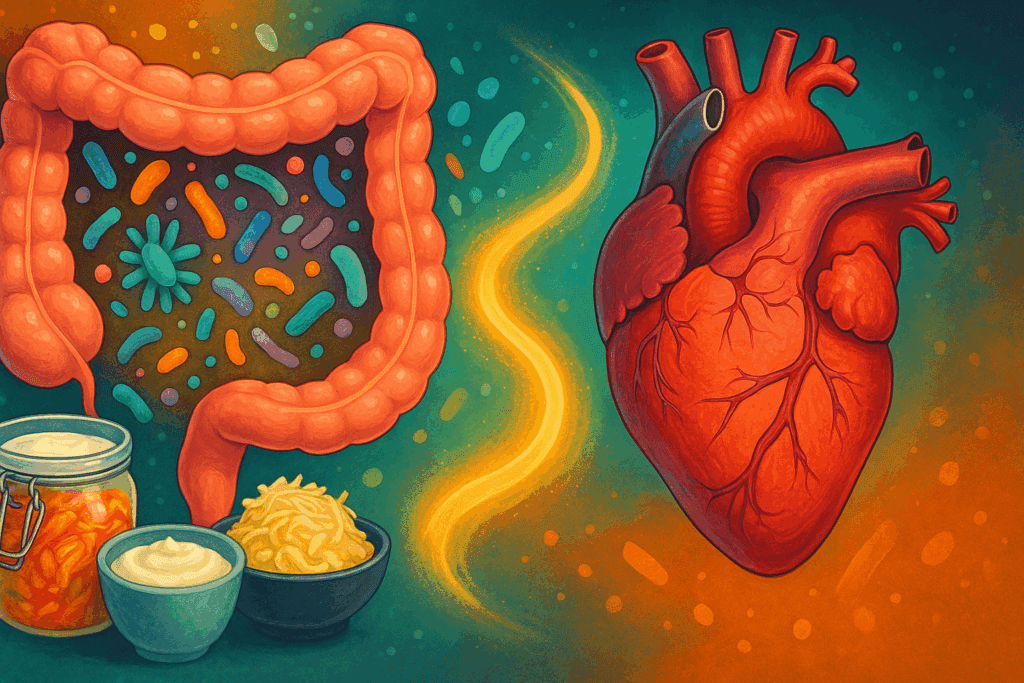
The Gut-Heart Axis: A New Frontier in Cardiovascular Health
An emerging area of research reveals that the health of our gut microbiome may directly influence arterial health. An imbalanced gut flora can lead to the production of harmful metabolites such as TMAO (trimethylamine-N-oxide), which promotes arterial plaque development.
Eating a diverse, fiber-rich diet that supports beneficial bacteria can protect against this risk. Fermented foods like kefir, yogurt, kimchi, and sauerkraut help restore healthy gut balance. Prebiotic-rich vegetables like garlic, onions, and asparagus feed the good bacteria already present.
Interestingly, endurance training itself also contributes to microbiome diversity and promotes the growth of beneficial strains. This bi-directional relationship between exercise and gut health adds another compelling layer to the question of how to prevent CAD through holistic means.

Sleep Quality and Circadian Health: Silent Guardians of the Arteries
Sleep is one of the most overlooked elements in cardiovascular prevention. Poor sleep quality, irregular sleep patterns, and sleep disorders like apnea all contribute to increased inflammation, higher cortisol levels, and disrupted metabolic processes—each of which can damage arterial walls over time.
People who consistently get less than six hours of sleep per night have a significantly increased risk of developing clogged arteries and CAD. Ensuring consistent sleep hygiene—such as maintaining a regular bedtime, limiting blue light exposure, and creating a restful environment—can improve arterial health and endurance capacity.
Aligning daily routines with natural circadian rhythms enhances melatonin production and helps regulate blood pressure and vascular tone. When sleep is optimized, the body has more time to repair itself, reducing wear and tear on the cardiovascular system.
Hydration and Its Underrated Role in Arterial Performance
Dehydration may not make headlines, but it directly impacts blood viscosity and circulation. Thickened blood due to low hydration levels can increase arterial resistance and contribute to plaque buildup. Moreover, dehydration impairs thermoregulation and cardiovascular efficiency during exercise.
Proper hydration ensures that blood flows smoothly and that nutrients and oxygen are delivered effectively. Drinking water consistently throughout the day—and especially during endurance activity—is key to maintaining cardiovascular performance. Adding electrolytes can be helpful for individuals who engage in high-intensity or long-duration training sessions.
Hydration isn’t just about drinking water when you’re thirsty; it’s about creating habits that support long-term vascular health and performance under stress. This simple, often ignored strategy can make a profound difference in how the heart and arteries function.

Frequently Asked Questions: How to Prevent Clogged Arteries and CAD Naturally
1. Can intermittent fasting help prevent clogged arteries and support healthy arteries long-term? Intermittent fasting has emerged as a promising strategy for cardiovascular health, offering benefits beyond weight management. Time-restricted eating has been shown to improve insulin sensitivity, reduce oxidative stress, and lower levels of inflammatory biomarkers, all of which contribute to healthier arteries. While research is still evolving, early studies suggest that intermittent fasting may reduce the progression of atherosclerosis by modulating cholesterol transport and immune function. For those wondering how to prevent clogged arteries in the heart, intermittent fasting can be a valuable adjunct to diet and exercise. When practiced safely and consistently, it encourages metabolic flexibility, which supports heart health and overall vascular resilience.
2. What role does emotional health play in preventing CAD and supporting healthy arteries? Chronic emotional stress is a lesser-known but significant factor in the development of coronary artery disease. Elevated stress levels stimulate the release of cortisol and adrenaline, which can raise blood pressure, disrupt sleep, and promote systemic inflammation. Over time, this biochemical environment contributes to endothelial dysfunction and increases the likelihood of plaque formation. Learning how to prevent CAD should include emotional regulation techniques such as journaling, therapy, or mindfulness training, which support both mental and cardiovascular health. Emotional stability and heart coherence are closely connected, and managing stress is essential for maintaining healthy arteries in the long term.
3. Are there any specific breathing techniques that improve arterial flexibility? Yes, deep diaphragmatic breathing and controlled breathing techniques, such as box breathing or paced respiration, have been shown to activate the parasympathetic nervous system and lower blood pressure. These techniques reduce heart rate variability and improve vagal tone, both of which are associated with vascular health. For individuals focused on how to prevent clogged arteries in the heart, breathwork may serve as a non-invasive method to regulate vascular tone and decrease sympathetic stress. Over time, consistent breathing practice can help reduce arterial stiffness and improve overall oxygen delivery to tissues. It’s an accessible tool that complements endurance training and nutritional strategies aimed at supporting healthy arteries.
4. How do environmental toxins influence the development of clogged arteries? Exposure to pollutants such as heavy metals, microplastics, and airborne particulate matter has been linked to increased cardiovascular risk. These environmental toxins promote oxidative stress, endothelial injury, and inflammation, all of which accelerate plaque development. Urban dwellers, in particular, may face higher risks due to air quality and proximity to industrial zones. To support healthy arteries, individuals should reduce toxin exposure by using water filtration systems, choosing organic produce when possible, and minimizing contact with synthetic chemicals. When exploring how to prevent CAD naturally, detoxifying one’s environment is a crucial but often overlooked factor.
5. Can cold exposure or cryotherapy improve cardiovascular resilience and prevent CAD? Cold exposure, such as cold showers or cryotherapy, may enhance vascular tone and improve circulation through a process known as vasoconstriction and vasodilation cycling. These adaptations strengthen blood vessels and improve metabolic efficiency. While more research is needed, some evidence suggests that routine cold exposure can reduce inflammation and support immune function, which are critical for preventing arterial damage. Individuals exploring how to prevent CAD through holistic means might benefit from incorporating controlled cold exposure as part of a broader endurance and recovery strategy. As with all interventions, it should be practiced with safety and supervision in mind.
6. How does social connection influence arterial health? Strong social bonds have a measurable impact on cardiovascular outcomes. Loneliness and social isolation have been linked to increased levels of stress hormones, systemic inflammation, and higher incidences of cardiovascular events. People with meaningful relationships often experience lower blood pressure, better sleep, and more consistent health behaviors. When considering how to prevent CAD, it’s important to look beyond physical factors and acknowledge the emotional and social components of wellness. Maintaining community connections can help regulate the nervous system and indirectly promote healthy arteries through reduced stress and improved mood.
7. Are there advanced wearable devices that help monitor risk factors for clogged arteries? Yes, modern wearable health technologies now offer real-time insights into heart rate variability, blood pressure trends, oxygen saturation, and even arterial stiffness. Devices equipped with photoplethysmography (PPG) and electrocardiogram (ECG) sensors can detect subtle changes in cardiovascular function. These tools empower users to make informed decisions about their fitness, stress management, and recovery routines. For those seeking new ways on how to prevent clogged arteries in the heart, leveraging wearable tech offers personalized data that can identify early warning signs and reinforce healthy habits. As technology evolves, these devices are becoming more accurate and integral to long-term heart health management.
8. What is the impact of shift work on the risk of developing CAD? Shift work, particularly night shifts, can disrupt circadian rhythms and increase the risk of metabolic syndrome, hypertension, and cardiovascular disease. Irregular sleep patterns negatively affect hormonal balance, blood sugar control, and vascular repair mechanisms. For those engaged in shift work, learning how to prevent CAD requires intentional strategies like maintaining consistent meal times, prioritizing dark environments for sleep, and integrating regular exercise. Circadian alignment is essential for arterial recovery, and mitigating circadian disruption can significantly improve long-term cardiovascular resilience. Healthy arteries rely not just on what you do—but when you do it.
9. How can heat therapy or sauna use benefit arterial health? Regular sauna use has been associated with improved endothelial function, reduced arterial stiffness, and lower blood pressure. Heat exposure causes vasodilation, which enhances blood flow and promotes relaxation. Studies from Finland, where sauna bathing is common, show lower cardiovascular mortality among regular sauna users. For individuals wondering how to prevent clogged arteries in the heart, sauna therapy offers a passive way to simulate some of the cardiovascular benefits of exercise. It may also assist in detoxification through sweat and enhance recovery after endurance activity, promoting both performance and healthy arteries.
10. Is there a genetic component to CAD, and can lifestyle override it? While genetics do influence CAD risk—through factors like cholesterol metabolism, blood pressure regulation, and inflammation—lifestyle has a powerful epigenetic impact. Emerging research shows that behaviors such as diet, physical activity, stress management, and sleep can activate or suppress specific genes related to heart disease. Understanding how to prevent CAD naturally means acknowledging genetic predispositions without being bound by them. Even those with a family history of heart disease can dramatically lower their risk by building habits that support healthy arteries. Epigenetics offers hope and empowerment, illustrating that our daily choices can reshape our biological destiny.
Conclusion: A Life Built on Strong Arteries and Stronger Choices
In the journey toward optimal health, few goals are more worthy than maintaining clear, flexible arteries. Understanding how to prevent clogged arteries in the heart and how to prevent CAD naturally empowers individuals to take control of their health destiny. It also aligns with a deeper goal—living with vitality, freedom, and resilience.
From endurance training and anti-inflammatory nutrition to quality sleep and gut health, the science is clear: lifestyle choices matter profoundly. They don’t just influence performance in the gym—they shape the future of our hearts. Every time we lace up our shoes for a run, choose a nourishing meal, or get a full night’s sleep, we cast a vote for our cardiovascular future.
Healthy arteries are the key to lasting performance, both in athletics and in life. By integrating these expert-backed strategies into our routines, we not only reduce the risk of CAD but also enhance our capacity to thrive. It is not just about adding years to life—but adding life to those years, powered by a strong, enduring heart.
Was this article helpful? Don’t let it stop with you. Share it right now with someone who needs to see it—whether it’s a friend, a colleague, or your whole network. And if staying ahead on this topic matters to you, subscribe to this publication for the most up-to-date information. You’ll get the latest insights delivered straight to you—no searching, no missing out.
Further Reading:
5 Expert-Backed Tips to Reduce Artery Blockage and Boost Heart Health

